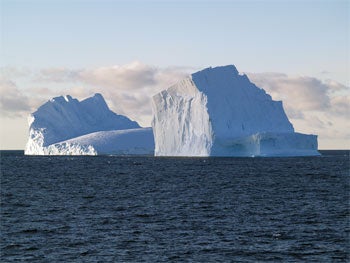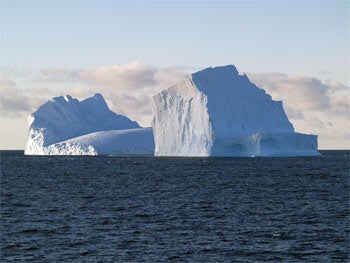 Study will help understand impacts of climate change
Study will help understand impacts of climate change
NARRAGANSETT, R.I. – June 25, 2007 – The Southern Ocean is warming faster than other oceans, and winds in the region have increased significantly in the last 30 years, so it is a key location to look for the impacts of climate change.
Two researchers from the University of Rhode Island’s Graduate School of Oceanography aim to do just that. They have been awarded a five-year, $2 million grant by the National Science Foundation to measure the current that flows around Antarctica.
“The Antarctic Circumpolar Current acts as a conduit transporting water between the Atlantic, Pacific and Indian Oceans. The nature of this interaction has consequences for local, regional and global ecosystems and climate,” explained Kathleen Donohue, URI associate research professor. “It’s important to understand the dynamics of the current so we can understand the impacts of our changing climate.”
The transport rate of the current is also a key measurement used to validate the accuracy of many numerical models used in oceanography and related fields.
“The Drake Passage is well suited for measuring the time-varying transport of the Antarctic Circumpolar Current, as a measure of the pulse of the Southern Ocean,” said Donohue.
The Drake Passage between Antarctica and the tip of South America is the current’s narrowest passage, a chokepoint that is an ideal location for this experiment. In November 2007, Donohue will be joined by URI Oceanography Professor Randy Watts and Teresa Chereskin of the Scripps Institution of Oceanography to deploy 35 current and pressure recording inverted echo sounders across Drake Passage.
Inverted echo sounders have been used to monitor oceanic fronts since the 1970s when URI Oceanography Professor Tom Rossby first introduced the concept of using travel time variations to monitor the depth of the main thermocline, the layer of water in which temperature changes more rapidly with depth than it does in the layers above or below. Since then inverted echo sounders have been successfully deployed around the world to study major oceanic fronts and currents.
In addition to the line of echo sounders measuring the transport rate of the current through Drake Passage, a more closely spaced array of instruments will also be placed there to help map circulation and eddy patterns. The researchers will make annual visits to the region aboard the U.S. Antarctic Program research vessels L. M. Gould or N.B Palmer to download the data collected by the instruments, leaving them undisturbed for a period of four years.
“Our observations will help us understand why the current is there, what forces it, and what controls its variability,” Donohue said. “We anticipate that the Antarctic Circumpolar Current may be highly sensitive to climate change. It is driven by winds, and since the winds appear to be changing as a result of climate change, the current may change as well.”
The research project will also result in recommendations for strategies for long-term monitoring of the current.

